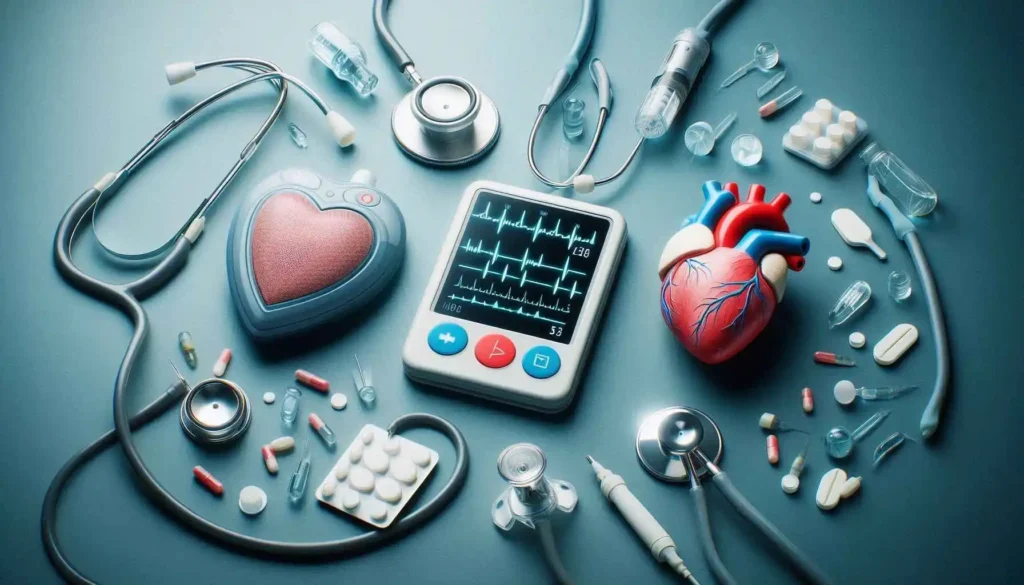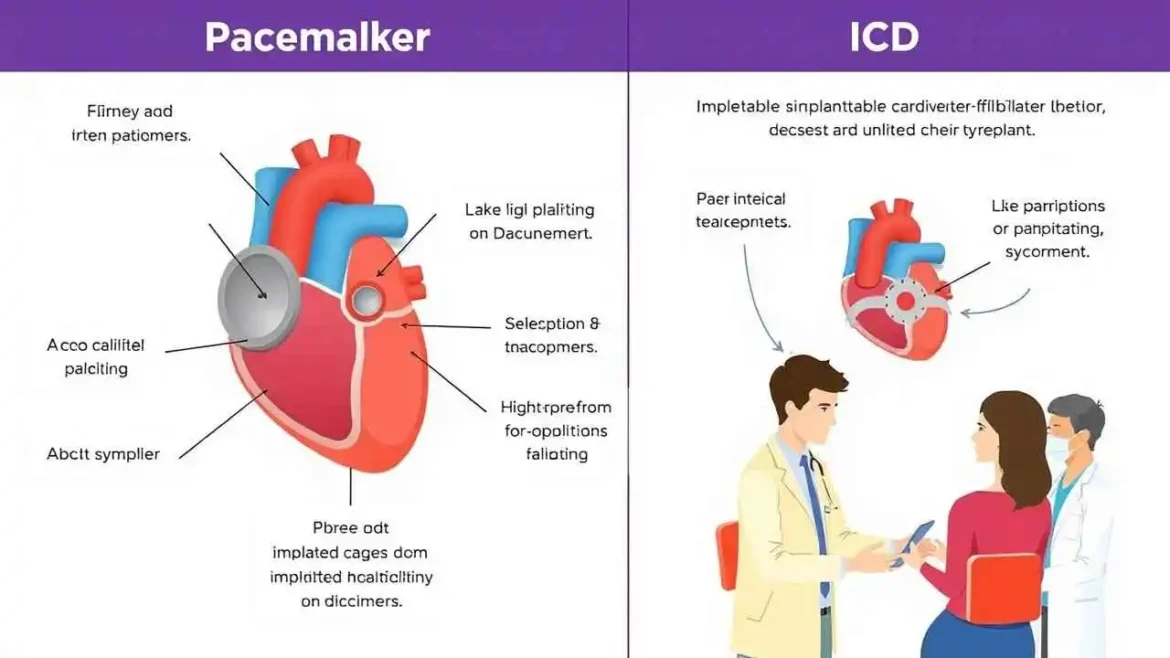
Why You Need Either a Pacemaker or ICD : Understanding the Right Choice
We often encounter confusion when discussing implanted heart devices. People may have heard of pacemakers and ICDs, perhaps even know someone who has one, but the specifics of what each device does and why a person might need one versus the other can be unclear. They are both incredible pieces of medical technology designed to help the heart function correctly, but they address very different problems within the heart’s complex electrical system.
Understanding the distinction between a pacemaker and an implantable cardioverter-defibrillator (ICD) is crucial, especially if you or a loved one is facing the possibility of needing one. It’s not simply a matter of different names for the same thing; these devices perform fundamentally different tasks to correct distinct types of abnormal heart rhythms. Our goal here is to illuminate these differences and explain why selecting the right device is a critical decision for heart health.
The Heart’s Electrical Symphony
Before we delve into the devices, let’s briefly touch upon why they are needed. Your heart beats thanks to a sophisticated internal electrical system. Electrical impulses start in a natural pacemaker area called the sinus node, travel through specific pathways, and tell the heart’s chambers (atria and ventricles) when to contract and pump blood. This system is a carefully orchestrated symphony, ensuring blood circulates effectively throughout your body.
However, this electrical symphony can sometimes go awry. The heart might beat too slowly (bradycardia), too fast (tachycardia), or with irregular, chaotic rhythms (like fibrillation). When these rhythm disturbances, or arrhythmias, become problematic, they can lead to symptoms like dizziness, fainting, fatigue, or, in the most severe cases, sudden cardiac arrest and death. This is where pacemakers and ICDs come into play – as expert electrical engineers for the heart.
What is a Pacemaker?
Let’s start with the pacemaker, the device that’s perhaps been around longer and is more widely recognized. At its core, a pacemaker is designed to treat heart rhythms that are too slow or irregular due to issues in the heart’s natural pacing system or electrical pathways.
Imagine your heart needs a steady drummer to keep the beat, but its natural drummer is unreliable – sometimes too slow, sometimes skipping beats entirely. A pacemaker acts as an external, reliable drummer.
A typical pacing system consists of:
- A Pulse Generator: This is a small metal case containing a battery and a tiny computer. It’s usually implanted under the skin near the collarbone.
- Leads (Wires): These are thin, insulated wires that are threaded through veins into the heart’s chambers. The leads connect the pulse generator to the heart muscle. At the tip of the leads are electrodes that can sense the heart’s natural electrical activity and deliver electrical pulses from the generator.
The pacemaker’s computer constantly monitors your heart’s rhythm. If it detects that the natural beat is too slow or has stopped, the generator sends a tiny electrical pulse through the lead(s) to stimulate the heart muscle, prompting it to contract. This ensures the heart beats at a rate sufficient to meet the body’s needs.
Pacemakers are commonly used to treat conditions such as:
- Sick Sinus Syndrome: The heart’s natural pacemaker (the sinus node) isn’t working correctly, leading to slow or irregular rhythms.
- Heart Block: The electrical signals from the upper chambers (atria) to the lower chambers (ventricles) are partially or completely blocked, causing the heart to beat too slowly.
- Bradycardia: A general term for a consistently slow heart rate that causes symptoms.
- Sometimes used for certain types of fast rhythms (tachycardia) that paradoxically respond to pacing.
Receiving a pacemaker can dramatically improve quality of life by relieving symptoms like chronic fatigue, dizziness, and fainting spells caused by a slow heart rate.
What is an Implantable Cardioverter-Defibrillator (ICD)?
Now, let’s look at the ICD. While an ICD can perform all the functions of a pacemaker (as many ICDs also have pacing capability), its primary and defining role is vastly different. An ICD is designed to detect and treat heart rhythms that are dangerously fast and potentially life-threatening, specifically those originating in the ventricles, such as ventricular tachycardia (VT) and ventricular fibrillation (V-fib).
Think of the heart’s electrical system not just needing a drummer but also a security system with a built-in automated external defibrillator (AED). If the electrical system goes haywire and the ventricles start beating chaotically or dangerously fast (like a strobe light rather than a steady beat), blood pumping stops effectively, leading rapidly to cardiac arrest. The ICD is the security system designed to detect this emergency and deliver a potentially life-saving intervention.
Like a pacemaker, an ICD system includes:
- A Pulse Generator: Similar to a pacemaker’s, but typically slightly larger. It contains a battery, a computer, and importantly, a large capacitor capable of storing energy for a shock. It’s also usually implanted under the skin near the collarbone.
- Leads (Wires): These are also threaded through veins into the heart. They sense heart rhythm and can deliver pacing pulses. One key lead often has a coil capable of delivering a higher-energy shock.
The ICD constantly monitors the heart rhythm. If it detects a dangerous, fast rhythm like VT or V-fib, it’s programmed to respond. Its responses can include:
- Anti-Tachycardia Pacing (ATP): Delivering a series of rapid pacing pulses to try and interrupt the fast rhythm and restore a normal one (often described as “pacing out” the rhythm).
- Cardioversion or Defibrillation: If ATP doesn’t work or if the rhythm is immediately life-threatening (like V-fib), the ICD charges its capacitor and delivers a high-energy electrical shock directly to the heart muscle. This shock is intended to momentarily stop all electrical activity in the heart, allowing the heart’s natural pacemaker to ideally resume a normal rhythm. This shock can be uncomfortable or even painful for the patient.
ICDs are primarily implanted in individuals who are at high risk of sudden cardiac arrest due to:
- Having survived a previous cardiac arrest caused by VT or V-fib.
- Having a history of VT or V-fib.
- Having certain structural heart conditions (like severe heart failure or dilated cardiomyopathy) that put them at high risk for these arrhythmias.
- Having certain genetic heart conditions (like Long QT Syndrome, Brugada Syndrome, or Hypertrophic Obstructive Cardiomyopathy) that predispose them to dangerous ventricular arrhythmias.
The purpose of an ICD is fundamentally to prevent sudden cardiac death by terminating these deadly rhythms when they occur.
“The heart’s rhythm is a fundamental expression of life. When it falters, our task is to restore its harmony, ensuring that life can continue its beat.”
Key Differences Summarized
To make the distinction crystal clear, let’s look at the main points of difference between a pacemaker and an ICD in a table:
| Feature | Pacemaker | Implantable Cardioverter-Defibrillator (ICD) |
| Primary Function | Treat slow or irregular heart rhythms | Treat dangerously fast, life-threatening rhythms |
| Target Rhythm Problem | Bradycardia (slow heart rate), Heart Block | Ventricular Tachycardia (VT), Ventricular Fibrillation (V-fib) |
| Response to Slow Rhythms | Provides electrical pulses to speed up heart | Often includes pacing function to speed up heart (like a pacemaker) |
| Response to Deadly Fast Rhythms (VT/V-fib) | Cannot treat, provides no shock function | Can deliver Anti-Tachycardia Pacing (ATP) or a high-energy electrical shock |
| Key Component Difference | Pulse generator + pacing leads | Pulse generator + pacing/shock leads + capacitor for shocks |
| Main Benefit | Relieves symptoms of slow heart rate, improves daily function | Prevents sudden cardiac arrest |
Notice that while an ICD can perform the basic pacing function of a pacemaker, a pacemaker cannot perform the life-saving defibrillation function of an ICD.
Why the Difference Matters
Understanding this distinction is paramount because the device implanted must be tailored precisely to the patient’s specific electrical problem.
- If you have a slow heart rate causing dizziness, you need a pacemaker to ensure the beat stays regular and fast enough. An ICD would be overkill; its shock function is unnecessary and could deliver painful, inappropriate shocks for a rhythm it’s not designed to treat.
- If you have a history of or are at high risk for life-threatening ventricular arrhythmias (VT/V-fib), you need an ICD. A standard pacemaker, which only treats slow rhythms, would offer no protection against sudden cardiac arrest caused by these fast, chaotic rhythms.
Choosing the wrong device essentially means you are unprotected against the specific electrical malfunction your heart is experiencing. It’s the difference between needing a tool to speed something up versus needing a tool to stop something chaotic and restart it safely.





